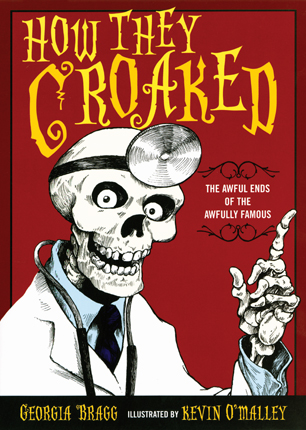Full Text Reviews: Booklist - 02/01/2011 *Starred Review* From George “Little Mouth of Horrors” Washington to Marie “You Glow, Girl” Curie, Bragg chronicles with ghoulish glee the chronic or fatal maladies that afflicted 19 historical figures. Nonsqueamish readers will be entranced by her riveting descriptions of King Tut’s mummification (and the brutal treatment that mummy has received in modern times); the thoroughly septic “doctoring” that hastened or at least contributed to the deaths of Mozart, Napoleon, James A. Garfield, and others; the literal dissolution of Henry VIII’s body (“While lying in state, it is believed that his toxic remains exploded, and some of his royal splendidness dripped out the sides of the coffin overnight”); and the outrageous fates of Einstein’s brain, Galileo’s fingers, and other coroners’ souvenirs. The author tucks quick notes on at least marginally relevant topics, such as leeching, scurvy, presidential assassins, and mummy eyes (“If mummy eyeballs are rehydrated, they return to almost normal size”), between the chapters and closes with generous lists of nontechnical print resources on each of her subjects. O’Malley’s cartoon portraits and spot art add just the right notes of humor to keep the contents from becoming too gross. Usually. Despite occasional farfetched claims—it’s hard to believe that Charles Darwin puked four million times, even though he was fanatical about keeping personal health records—this all-too-informative study deserves the wild popularity it will without doubt acquire. - Copyright 2011 Booklist. Bulletin for the Center... - 03/01/2011 Bragg holds forth on nineteen Big Names whose demises have raised eyebrows, questions, and probably a few lunches. She begins with the pharaoh Tutankhamun and the way advanced forensic technology keeps resulting in updated judgments on his cause of death. She then marches steadily through short chapters on the likes of Julius Caesar, Henry III, Marie Antoinette, Edgar Allan Poe, and Marie Curie, offering the briefest biographical data on their importance in an animated state but lingering with the gory relish promised by the volume’s cover art over their passing. Bragg is largely up to date on her theories, discussing Charles Dickens’ mood swings in terms of probable bipolar disorder and ditching old rumors of Henry VIII’s syphilis in favor of less titillating gout, leg infection, and diabetes. The colloquial jokiness of the delivery-which will admittedly be what draws most kids in and gets them to stick around-occasionally pushes the envelope of good taste and period-reasonable tone (she gleefully imagines Galileo flipping the bird at his Inquisitors, and she suggests that Dickens “ripped his manager a new one” for shortening an engagement tour). Never letting nuance, science, or historical understanding get in the way of a good zinger, the author also chucklingly implies that George Washington’s tooth problems may have been the cause of his childlessness, and that Charles Darwin (who lived to seventy-three and fathered ten children) was “one of the weaker ones” in evolutionary terms. No source notes appear for any of the trivia that follows the entries, although the appended bibliographies for each chapter suggest that Bragg has done her homework. Not that readers will be concerned: carried away on a swift-flowing stream of body fluids, medical ineptitude, and O’Malley’s deliciously snarky artwork, kids will agree they got exactly what they came for. EB - Copyright 2011 The Board of Trustees of the University of Illinois. School Library Journal - 04/01/2011 Gr 5–9—King Tut died of malaria; Edgar Allan Poe is suspected to have had rabies. Beethoven and Galileo both met their ends due to lead poisoning. Fifteen other historical figures, including world leaders, writers, and scientists, were felled by things as mundane as pneumonia and as unpredictable as angry mobs. Each entry provides the circumstances of the person's death and gives context to those circumstances, from discussions of the political climate to medical practices of the time. Chapters are separated by a spread of brief facts related to the individual, the demise, or the era. Lively, full-page caricatures set in decorative frames appear throughout, along with spot illustrations. Back matter includes a lengthy list of sources. The sometimes-snarky writing gives the material a casual, conversational tone that will appeal to many readers. The title alone provides an easy booktalk; expect this one to be passed around and pored over.—Brandy Danner, Wilmington Memorial Library, MA - Copyright 2011 Publishers Weekly, Library Journal and/or School Library Journal used with permission. Loading...
|



